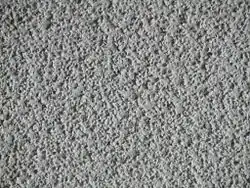Popcorn ceiling
A popcorn ceiling, also known as a stipple ceiling, stucco ceiling or acoustic ceiling, is a ceiling with one of a variety of spray-on or paint-on treatments. Bumpy surface is created by tiny particles of vermiculite or polystyrene that give it sound-deadening properties. Mixtures are available in fine, medium, and coarse grades.[1]

In many parts of the world, it was the standard for bedroom and residential hallway ceilings for its bright, white appearance, ability to hide imperfections, and acoustical characteristics. In comparison, kitchen and living room ceilings would normally be finished in smoother skip-trowel or orange peel texture for their higher durability and ease of cleaning. Popcorn ceilings, in pre-1970s and early formulations, often contained white asbestos fibers. When asbestos was banned in ceiling treatments by the Clean Air Act in the United States,[2] popcorn ceilings fell out of favor in much of the country. However, in order to minimize economic hardship to suppliers and installers, existing inventories of asbestos-bearing texturing materials were exempt from the ban, so it is possible to find asbestos in popcorn ceilings that were applied through the 1980s. After the ban, popcorn ceiling materials were created using a paper-based or Styrofoam product to create the texture, rather than asbestos. Textured ceilings remain common in residential construction in the United States.
Since the mid-2000s, the popularity of textured popcorn ceilings has diminished significantly across North America.[3] A trend toward more modern, clean-lined design features has influenced home improvement professionals to provide popcorn ceiling removal services. Smooth ceilings have many benefits over the textured ceiling, such as their association with a high-end aesthetic, they are more reflective bouncing natural light throughout the room space (especially in combination with high gloss floors), do not harbor dust and allergens (only to be re-introduced into the air), easier patching and touching up after a drywall repair, etc.
See also
References
- Lemmer, Tom. Black & Decker The Complete Guide to Finishing Walls & Ceilings, p. 125, at Google Books
- http://www.epa.gov/asbestos/pubs/ashome.html#example Asbestos in Your Home at EPA.com
- Stamp, Elizabeth. "How to Remove Popcorn Ceilings in 5 Simple Steps". Architectural Digest. Retrieved 2020-09-27.